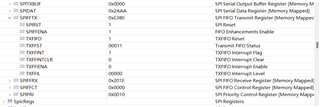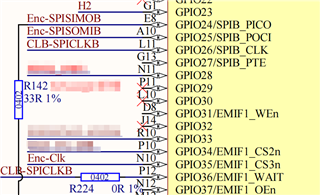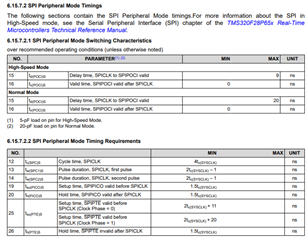Tool/software:
Hello engineers,
SPICLK and PTE are normal. Data was written to SPITXFIFO and three pieces of data were written. It was observed that the data had entered the SPIDAT shift register, but it just couldn't be sent out.
LSPCLK is configured to 20 MHz.SPI is configured as a slave device. The specific configuration is as follows:
|
void endat22_spi_fifo_init() { //
// Initialize SPI FIFO registers
//
SPI_disableModule(PM_ENDAT22_SPI);
SPI_disableLoopback(PM_ENDAT22_SPI);
SPI_setConfig(PM_ENDAT22_SPI, DEVICE_LSPCLK_FREQ_20M, SPI_PROT_POL1PHA0,
SPI_MODE_PERIPHERAL, 500000, 9);
SPI_enableFIFO(PM_ENDAT22_SPI);
SPI_setEmulationMode(PM_ENDAT22_SPI, SPI_EMULATION_FREE_RUN);
SPI_enableModule(PM_ENDAT22_SPI);
SPI_resetTxFIFO(PM_ENDAT22_SPI);
SPI_resetRxFIFO(PM_ENDAT22_SPI);
} |
CLB generates SPICLK(200kHz) and connects it to the GPIO port of SPICLK through an external connection,GPIO_23 has been grounded:
| GPIO_setPinConfig(GPIO_24_SPIB_PICO); GPIO_setPadConfig(24, GPIO_PIN_TYPE_STD | GPIO_PIN_TYPE_PULLUP); GPIO_setQualificationMode(24, GPIO_QUAL_ASYNC); GPIO_setPinConfig(GPIO_25_SPIB_POCI); GPIO_setPadConfig(25, GPIO_PIN_TYPE_STD); GPIO_setQualificationMode(25, GPIO_QUAL_ASYNC); //原理图中GPIO27应为SPIB_PTE,但未接地;临时使用GPIO23替代 GPIO_setPinConfig(GPIO_23_SPIB_PTE); GPIO_setPadConfig(23, GPIO_PIN_TYPE_STD); GPIO_setQualificationMode(23, GPIO_QUAL_ASYNC); GPIO_setPinConfig(GPIO_26_SPIB_CLK); GPIO_setPadConfig(26, GPIO_PIN_TYPE_STD | GPIO_PIN_TYPE_PULLUP); GPIO_setQualificationMode(26, GPIO_QUAL_ASYNC); |

The SPICLK generated by the measured CLB is shown in Figure 4 below:


